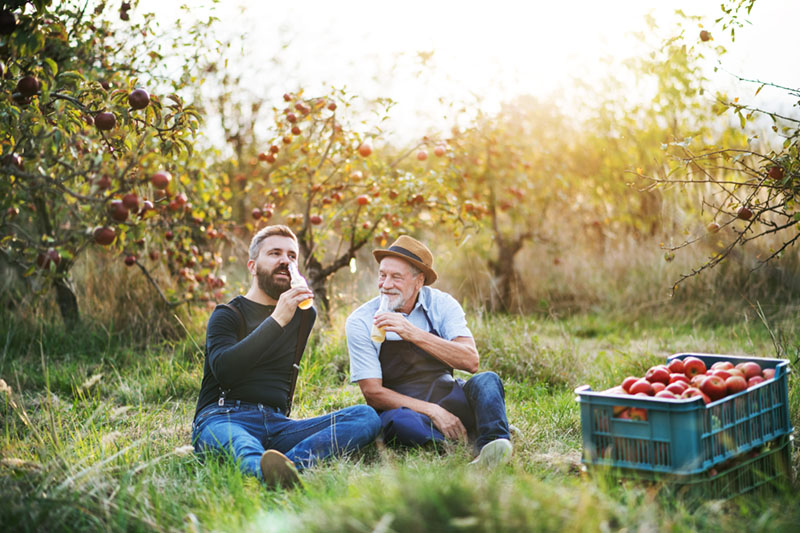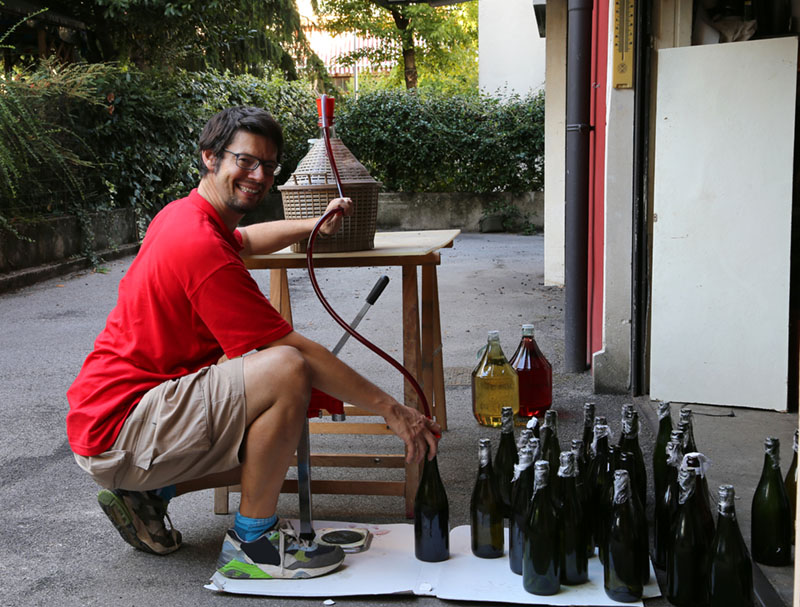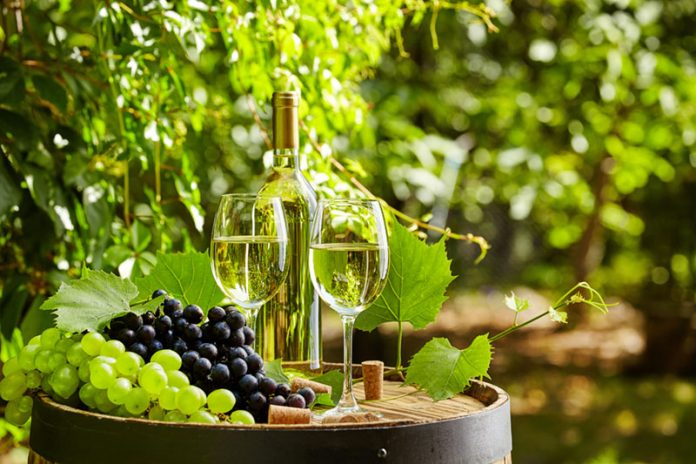Is the glass half full or half empty? The question surrounding eco-friendly alcohol options is just as complex. There’s no better thing to toast to than our planet, but many of us are wondering how to do that sustainably.
Fortunately, there are many booze brands that are trying to be better for Earth. While it’s difficult to say definitively that one type of alcohol is more planet-friendly than another, we can provide some considerations to help you celebrate responsibly and sustainably.
Let the glasses clink and the planet heal with some of the most eco-friendly alcohol options.
The Most Eco-Friendly Alcohol Options
Cider
Cider requires little in terms of water and energy for distillation, and it’s also typically made with just a few ingredients that can easily be locally produced. It’s made in a relatively simple process, too—just wash and mash the apples, and let fermentation make the magic happen.

Compared to other alcohol crops (sugarcane, agave plants, barley, hops, and corn), apple trees provide more biodiversity and absorb more carbon dioxide!
Beer
As a general rule of thumb, the higher the alcohol content, the higher the environmental impact (Vice). This makes beer an excellent beverage of choice—even more so when it’s from an eco-friendly beer company.
When it comes to beer that won’t give our planet a hangover, local is best, as is beer that’s made with sustainably-produced ingredients. Generally speaking, barley has a heavy environmental footprint, and requires a lot of pesticides and fertilizers. Only 0.02% of the barley grown in the US is organic, but hopefully this number will grow in coming years.
And you can let your inner frat boy rejoice—beer from a keg is the most environmentally friendly way to drink.
Wine
A 2007 study by the American Association of Wine Economists found that the bulk of wine’s environmental impact takes place during its transportation stage. This is nothing to wine about, especially if you live close to California.
If you live elsewhere, check out ‘The Wine Line’ from Mother Jones. It shows where winos would do better to drink European wines (like anyone on the East coast).
Given that transportation takes its toll on our planet, consider purchasing wine that has a lighter load (read: brands who use recyclable, paper-based packaging or thinner glass bottles).
Distilled Spirits
Distilled spirits are more likely to give you a massive hangover, and the same goes for our planet. Compared with cider, wine, and beer, they typically require more energy during production, and almost all of the water required ends up as waste.
We don’t want to prevent you from enjoying that winter hot toddy or summertime margarita, so here are some additional things to consider:
- Whiskey: Only one grain source goes into single malt Scotch, whereas American whiskey is typically made with a mixture of barley, wheat, rye, and corn. Unfortunately, that single malt is likely produced in a traditional and energy-intensive way, when major American bourbon producers use more efficient practices and often reuse the barrels.
PRO TIP: Maker’s Mark has a sustainability team and uses a mixture of local red winter wheat, corn, and barley from family farms. They also have their own water source and implement practices to protect local water sources and land.
- Tequila: For every liter of finished tequila, more than ten times as much liquid waste (called vinaza)—along with agave plant residue (called bagasse)—are illegally dumped. This has a negative environmental impact, particularly in tequila-producing areas in Mexico.
PRO TIP: Patron composts their scrap agave to grow vegetables. They also have a water treatment facility on-site. Tequila Cazadores fuels 100% of their distillery using agave waste biomass—making them carbon-neutral. Casa Noble grows their agave on site and manages waste by producing tequila in small batches.
- Rum: Rum is made from either cane juice or molasses (or in some cases, GMO sugar beets). Sugarcane is a destructive crop—known for its greenhouse gasses and wastewater, and the production of rum itself is also known for requiring a lot of energy and polluting water.
PRO TIP: Puerto Rico’s Serralles Rum Distillery composts sugarcane waste, treats their own water, and uses biomass to generate 50% of the energy required for distillation.
- Gin and Vodka: While vodka was traditionally made from potatoes now it, along with gin, is commonly made with a mixture of grains. Unfortunately, compared with other spirits, they both require a lot of energy and water, too.
PRO TIP: Check out gin made from peas, or try the gin or vodka made by LA-based Greenbar Distillery. It uses only certified organic ingredients, lightweight bottles (less shipping/packaging emissions), and plants a tree for every purchase!
Tips for Sipping Sustainably
We should also probably elaborate on why a boozy brunch is taxing on the planet. Like any other products we consume, one of our favorite ways to wind down requires a lot of resources and energy.
Let’s start with the fact that alcohol is thirsty—just as thirsty as you’ll be after waking up with a slight hangover. For most types of alcohol, water is essential in every step of the process, yet very little ends up in your wine glass, shot glass, or bottle.
To make a pint of beer, about 20 gallons are required. Fortunately, this is significantly less than the 132 gallons required to produce a 2-liter bottle of soda so if you’re craving a rum and coke, maybe rethink the latter…
Then we have to consider the farmed ingredients that make it into that questionable happy hour concoction… While this isn’t always the case, many times the barley, agave, sugarcane, grapes, etc. will use a significant amount of fertilizer in addition to irrigated water.
From some of the world’s biggest alcohol producers, this might also mean huge swaths of mono-cropped land where biodiversity is harmed, or even land that’s deforested to plant alcohol crops instead.
The manufacturing stage also has potential to wreak havoc on our planet. Typically, a great deal of energy is required to heat, cool, and distill the ingredients.
Then we get to the storage and transportation requirements of your adult beverage of choice. Refrigeration plays a huge part in getting that flavorful double IPA from the brewery to your mouth, and it also uses up a lot of energy—even more so when it’s a refrigerated truck that also is guzzling fossil fuels…
That leaves the biggest environmental impact of all: packaging. In one Carbon Trust test with the brewer, Carlsberg, they found that around 40% of the beer’s total carbon footprint came from the packaging.
Think Local
According to The Guardian, beer that’s consumed and brewed locally may have ingredients and a product that travels as little as 600 miles. On the other hand, beer coming from one of the world’s big breweries could be made with ingredients and in a process that accumulates around 24,000 miles.
Not only is local beer better for local economies, but it’s better for our planet, too.
Make Your Own!
If you want to be a truly sustainable sipper, why not try to brew your own! There are an abundance of resources available for any novice or seasoned alcohol producer and while making homemade tequila may be a little difficult, cider and beer are something nearly anyone can tackle (plus, it’s a great way to reuse bottles!).

If you’ve brewed your own or have any other sustainable alcohol brands in mind, please share any tips or recommendations in the comments below!














